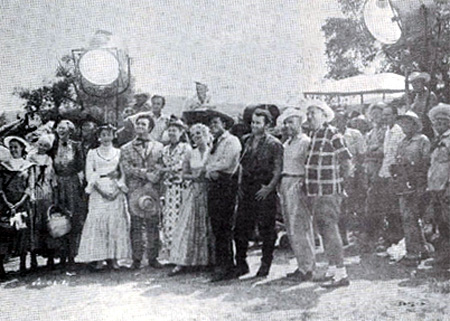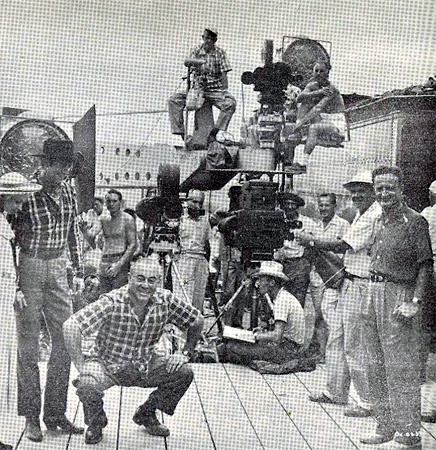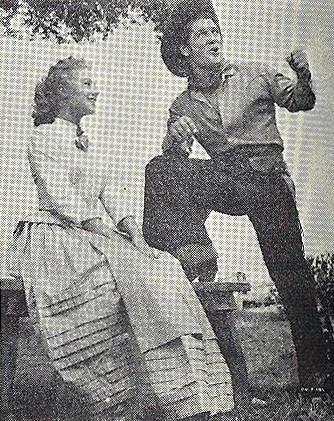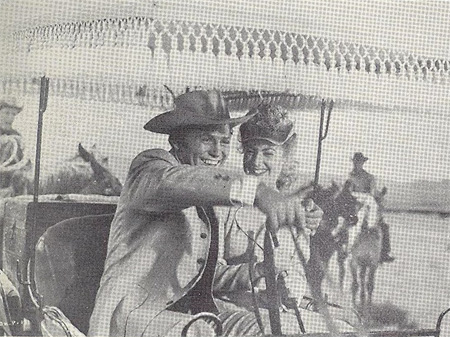"Oklahoma!" - The First Movie Produced By Todd-AO |
Read more at in70mm.com The 70mm Newsletter |
| Story told by: Gordon MaCrae, Actor, in AO magazine "The Reflector", Brattleboro, VT. Friday, April 22, 1955. Article supplied by Dick Whitney (AO Heritage Museum), and re-typed by Anders M. Olsson (Sweden). | Date: 10.07.2012 |
The New Miracle of the Movies | |
|
(Hollywood, California... Special) How would you like to be in a motion
picture theatre, and as you hear "Curly" sing the lyrics of "the corn is as
high as an elephant's eye" find yourself in the corn trying to brush the
tassels out of your own eyes?
That is the feeling you will get when you see Rodgers and Hammerstein's
"Oklahoma!" the first movie produced in the
Todd-AO process. Again, I ask you. How would you like to be so close to "Laurey" as though you would be able to touch her? I am sure you'd like it, since "Laurey" happens to be Shirley Jones, the real Cinderella of this century. All these sensations and many more will be realized by you when you see this wonderful musical filmed in the revolutionary, miracle-magic The Todd-AO Process. |
More in 70mm reading: Todd-AO Todd-AO Process Shown At MGM Studio Full credits for "Oklahoma!" The Todd-AO Saga Part #1 Internet link: Dick Whitney's Todd-AO Page |
How Was "Oklahoma!" Made? | |
 Cast,
producers, directors, cinematographer, and crew of Rodgers and Hammerstein's
"Oklahoma" filmed in Todd-AO Cast,
producers, directors, cinematographer, and crew of Rodgers and Hammerstein's
"Oklahoma" filmed in Todd-AOOn Sunday night, May 15, over the NBC-TV network on the Colgate Comedy Hour, I will act as the host of one of the most important telecasts of my career. At that time, I will tell the story of how "Oklahoma!" was made. I will be helped in my storytelling with most of the principals from "Oklahoma!", including the wonderful team of Rodgers and Hammerstein. However, here is a scoop for you. This is my story on how "Oklahoma!" was made in Todd-AO, as I know it best. Todd-AO is a new deep curved screen process whose name is a combination of the names of Michael Todd who instigated the design and the American Optical Company, whose battery of more than 100 scientists and engineers, under the leadership of a great scientists, Dr. Brian O'Brien, perfected it. Joseph Scheneck, chairman of the board and George P. Skouras, president of Magna Theatre Corporation, co-ordinated the entire project and brought it to its successful fruition with the filming of "Oklahoma!" |
|
Worked Ten Years to Film "Oklahoma!" | |
 Richard Rodgers, of the team of Rodgers and Hammerstein, squats down for a
better look at the dance rehearsal which is in progress. At extreme right is
Director Fred Zinnemann. Richard Rodgers, of the team of Rodgers and Hammerstein, squats down for a
better look at the dance rehearsal which is in progress. At extreme right is
Director Fred Zinnemann.For ten years, since the musical play "Oklahoma!" opened in New York City, March 31, 1943, the major movie companies made overtures to Rodgers and Hammerstein for the movie right of "Oklahoma!" Nothing happened until one day when both Dick and Oscar were invited to see test shots of the Todd-AO process. Then it became obvious that the movies were ready for "Oklahoma!" Rodgers and Hammerstein organized their own producing company; Magna Theatre Corporation is releasing "Oklahoma!" and Fred Zinnemann took over the job of director with Arthur Hornblow, Jr., as the producer. By the way, I am in the picture and play "Curly." I loved it. Gloria Grahame is "Ado Annie"; Gene Nelson is "Will Parker"; Charlotte Greenwood is "Aunt Ellen"; Eddie Albert is "Ali Hakim"; James Whitmore is "Andy Carnes"; Shirley Jones is "Laurey"; Rod Steiger is "Jud"; Barbara Lawrence is "Gertie Cummings"; Jay C. Flippen is "Skidmore"; Roy Barcroft is "Cord Elam", Agnes de Mille designed the dances. When you see "Oklahoma!" filmed in Todd-AO you will see it on a 70mm film, twice the size of conventional film. It's in Eastman Color and the sound is six channels stereophonic. About one third of the film was shot on outdoors location spots. The state of Oklahoma, the company's natural first choice, for outdoor location sites was vetoed after extensive surveys, which crisscrossed the state, revealing that there would be little opportunity to capture scenic beauty without running into commercial development. The selection of the location site in Arizona was not an impulsive one. More than 250,000 miles were logged by Rodgers and Hammerstein executives before the company settled on the area surrounding Nogales. |
|
"Corn As High As An Elephant's Eye" | |
 Here Gordon MacRae as "Curly," telling "Laurey" (Shirley Jones) how he plans
to take her to the Box Social sings "The Surrey With the Fringe on Top. Here Gordon MacRae as "Curly," telling "Laurey" (Shirley Jones) how he plans
to take her to the Box Social sings "The Surrey With the Fringe on Top.The requirements were high corn, superb clouds, green valleys, open country and a sky free of airplanes. Only the San Rafael Valley, 36 miles northeast of Nogales, satisfied all of these conditions. Once the location site was selected, things began happening. At a cost of $100,000 a complete farmhouse was built with a two-story dwelling, a barn, a windmill, a smokehouse and a hurricane cellar. Ten acres of corn, seven acres of wheat and a peach orchard were planted. As there was no natural water supply, wells were dug with the consent of the State Government to irrigate the crops. The fields were planted with the stipulation that they be at the peak of growth on July 14, the date designated by director Zinnemann as the shooting day for the picture. Another major location site was the railroad station at Elgin, a tiny whistle stop (population 17 people and 24 cameras) about fifty miles from Nogales. Here was staged one of the most spectacular dance sequences ever put on film. Called, "Kansas City," it tells of the arrival back to the Oklahoma territory from the big city of an impressionable young cowboy (Gene Nelson). In pantomiming his views of the world beyond the plains, Gene dances up and down the railroad platform, jumps aboard a moving train, climbs up its side, prances about on the top and finally leaps off onto a galloping horse which has followed it. The third location was on a ranch at Amado, mid-way between Tucson and Nogales. Here is where the corn was as high as an elephant's eye, rising more than 13 feet in the air. This is the opening scene of the picture where I, on horseback, ride through a field of waving corn and when you see it you will find yourself right there with me trying to brush the corn tassels out of your own eyes. |
|
325 People In Location | |
 "Riding gaily in the Surrey with the fringe on the top, this happy couple,
"Curly" (Gordon MacRae) and "Laurey" (Shirley Jones) are shown in a scene
from Rodgers & Hammerstein's production of "Oklahoma!" filmed in Todd-AO.
The scene depicted is the one where they have just left their wedding and
have received the news that their home, Oklahoma territory, has just been
admitted as the 46th state in the union. "Riding gaily in the Surrey with the fringe on the top, this happy couple,
"Curly" (Gordon MacRae) and "Laurey" (Shirley Jones) are shown in a scene
from Rodgers & Hammerstein's production of "Oklahoma!" filmed in Todd-AO.
The scene depicted is the one where they have just left their wedding and
have received the news that their home, Oklahoma territory, has just been
admitted as the 46th state in the union.The company remained on location a total of seven weeks. Numbering 325 people at its peak, it was one of the biggest location jaunts in Hollywood history. More than 70 trucks and trailers were required to transport all the company's props and equipment. Many of the farm implements used to dress the set are collector's items. Among the rarer pieces were a wooden harvester with the date 1897 stamped on it, copies of the Police Gazette for 1903 and 1904, a Spanish-American War enlistment poster and a "September Morn-type" calendar, dated 1906. Back at the studio in Hollywood, the company continued to blaze new production trails. For the box supper auction sequence, for example, it constructed one of the largest sets ever built on a sound stage, size 180 feet by 300 feet, -- the size of a football field. The painted backdrop, which encircled it, measured 40 feet by 500 feet and matched in its colors, the location backgrounds. |
|
De Mille Stage Dream Ballet | |
|
The dream ballet, which is seventeen minutes long in its final cut of the
picture, went before the cameras on November 9 and was completed on December
1st. Twice Academy Award winner, Robert Surtees photographed "Oklahoma!" in
Todd-AO. Shooting the dream ballet gave Surtees one of the toughest
production problems he ever faced. At an early point of the dance, a veil
floats down to earth and Agnes de Mille, famous dance director, requested
that it be caught in its flight in a shaft of heavenly light. Surtees tried
lighting the set in a dozen different ways but was unable to achieve the
desired effect. The solution was finally reached when Irving Sindler, the
head property man, climbed a step ladder just out of camera range and
sprayed the veil with gold dust as it floated down to the floor. The music of "Oklahoma!" which you will hear on a six channel stereophonic sound system was scored by a 75-piece orchestra assembled by Bobby Helfer and conducted by Jay Blackton. "Oklahoma!" marks the introduction of Rodgers and Hammerstein as a motion picture producing team, I do hope that it won't be the last effort. Movies need these two guys. They have something new, something vital, something wonderful to give us. They are, in my humble opinion, an American Institution. "Oklahoma!" will be shown in fifty leading cities on a two-a-day reserved seat basis in 1955. |
|
| Go: back - top - back issues - news index Updated 28-07-24 |
